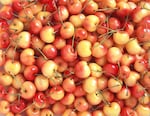
Rainier cherries from the Northwest.
Courtesy of the Washington State Fruit Commission
Cherry farmers in nine Oregon counties will be able to apply for federal loans and aid from the U.S. Department of Agriculture following one of the worst growing seasons on record.
Oregon Gov. Tina Kotek announced Friday that cherry farmers in Clackamas, Gilliam, Hood River, Jefferson, Marion, Multnomah, Sherman, Wasco and Wheeler counties will be eligible for federal loans and aid to make up for losses from 2023. Last year, farmers experienced one of the shortest ever cherry growing seasons since tracking by Oregon State University began in 1945. By the end of the season, production was down 35% due to a long cool spring with excessive rain followed by rapid heating and drought.
Cherry growers can learn more about USDA aid here.
“Oregon farmers faced serious economic losses during last year’s crop season,” Kotek said in a news release Friday. “This designation is critical to ensure that farmers are able to receive support from the federal government in recuperating those losses.”
Farmers have eight months to apply for loans and other aid from the U.S. Department of Agriculture’s Farm Service Agency.
The announcement follows a request in September from Kotek to Secretary of Agriculture Tom Vilsack for an emergency declaration.
Oregon’s sweet cherry industry had a banner year in 2020, with production worth nearly $134 million. But that dropped by about 50% in 2021 to $65 million, rising just 5% by 2022, according to USDA data. The Oregon agriculture industry is worth $5 billion a year.
In the summer of 2022, Oregon cherry farmers were paid $1.10 per pound for cherries. Last summer, prices dropped to less than 55 cents per pound. This was due not only to smaller fruit harvests, but also to a late harvest in California due to erratic weather.
California’s harvest season, which typically runs from mid-May through June, was three weeks late last year, and the state’s harvest doubled from the year prior. The late harvest pushed close to Oregon’s harvest season, creating competition that drove down prices for Oregon growers, according to Mike Doke, executive director of the Columbia Gorge Fruit Growers Association. The group represents more than 400 fruit growers in five counties in Oregon and Washington.
Doke previously told the Capital Chronicle that some growers considered leaving up to half of their cherries unpicked during the 2023 harvest because the cost of labor would have exceeded any profits from selling the cherries.
Oregon Capital Chronicle is part of States Newsroom, a network of news bureaus supported by grants and a coalition of donors as a 501(c)(3) public charity. Oregon Capital Chronicle maintains editorial independence. Contact Editor Lynne Terry for questions: info@oregoncapitalchronicle.com. Follow Oregon Capital Chronicle on Facebook and X.